Materials: LDPE bags are primarily made from Low-Density Polyethylene (LDPE), which is a type of thermoplastic polymer. LDPE is formed by the polymerization of ethylene monomers into long-chain molecular structures.
Characteristics: LDPE possesses the following characteristics:
Lightweight, durable, and semi-transparent.
Good chemical and heat resistance, typically used at temperatures below 110°C.
Excellent impact resistance and flexibility.
Good barrier properties against gases and liquids.
Manufacturing: LDPE bags are usually manufactured through blowing film or cast film blowing processes. Blowing film involves melting LDPE and passing it through a blow tube to form a film, which is then cooled and solidified. Cast film blowing is a process where melted LDPE is passed through a cast film extruder to form a film, which is then blown into a bag.
Usage Methods
Storage:
Keep the bags dry and away from damp environments to prevent deformation or damage due to moisture.
Avoid direct sunlight exposure for extended periods, as UV radiation can lead to aging of the bags.
Usage:
Choose the appropriate bag size for your needs to ensure items can be safely placed inside.
Be careful when handling to avoid puncturing the bag with sharp objects.
For food storage, ensure the bag is food-grade and free of odors, and clean the interior thoroughly before use.
Filling:
Gently place items into the bag, avoiding overfilling that could lead to tearing.
For bags that require sealing, such as food storage bags, ensure they are sealed correctly to maintain freshness and safety.
Transportation:
During transportation, avoid heavy pressure and folding to prevent damage to the bags.
For fragile items, use bubble wrap or other cushioning materials inside the LDPE bag for additional protection.
Recycling:
After use, if recycling facilities are available, sort the LDPE bags for recycling to reduce environmental impact.
LDPE bags are widely used in various applications due to their convenience, durability, and cost-effectiveness, including food packaging, household storage, garbage bags, and shipping packaging. Proper use and maintenance of these bags can extend their lifespan and minimize environmental impact.



